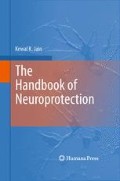Abstract
Although the concept of neuroprotection was originally applied to acute neurological conditions, it has been extended to chronic diseases of the brain characterized by neurodegeneration because some of the basic mechanisms of damage to the CNS are similar in these conditions.
Access this chapter
Tax calculation will be finalised at checkout
Purchases are for personal use only
References
Azarashvili T, Stricker R, Reiser G. The mitochondria permeability transition pore complex in the brain with interacting proteins – promising targets for protection in neurodegenerative diseases. Biol Chem 2010;391:619–29.
Boddaert N, Le Quan Sang KH, Rötig A, et al. Selective iron chelation in Friedreich ataxia: biologic and clinical implications. Blood 2007;110:401–8.
Chambraud B, Sardin E, Giustiniani J, et al. A role for FKBP52 in Tau protein function. Proc Natl Acad Sci U S A 2010;107:2658–63.
Chandra S, Gallardo G, Fernández-Chacón R, et al. α-Synuclein cooperates with CSPα in preventing neurodegeneration. Cell 2005;123:383–96.
Cook C, Zhang YJ, Xu YF, et al. TDP-43 in neurodegenerative disorders. Expert Opin Biol Ther 2008;8:969–78.
Craft JM, Watterson DM, Van Eldik LJ. Neuroinflammation: a potential therapeutic target. Expert Opin Ther Targets 2005;9:887–900.
Custer SK, Garden GA, Gill N, et al. Bergmann glia expression of polyglutamine-expanded ataxin-7 produces neurodegeneration by impairing glutamate transport. Nat Neurosci 2006;9:1302–11.
Dong J, Canfield JM, Mehta AK, et al. Engineering metal ion coordination to regulate amyloid fibril assembly and toxicity. Proc Natl Acad Sci U S A 2007;104:13313–8.
Jang SW, Liu X, Chan CB, et al. Amitriptyline is a TrkA and TrkB receptor agonist that promotes TrkA/TrkB heterodimerization and has potent neurotrophic activity. Chem Biol 2009;16:644–56.
Kaul M, Lipton SA. Signaling pathways to neuronal damage and apoptosis in human immunodeficiency virus type 1-associated dementia: chemokine receptors, excitotoxicity, and beyond. J Neurovirol 2004;10(Suppl 1):97–101.
Klawe C, Maschke M. Flupirtine: pharmacology and clinical applications of a nonopioid analgesic and potentially neuroprotective compound. Expert Opin Pharmacother 2009;10:1495–500.
Kramer ER, Aron L, Ramakers G, et al. Absence of Ret signaling in mice causes progressive and late degeneration of the nigrostriatal system. PLoS Biol 2007;5:e39.
Kvam E, Nannenga BL, Wang MS, et al. Conformational targeting of fibrillar polyglutamine proteins in live cells escalates aggregation and cytotoxicity. PLoS One 2009;4(5):e5727.
Kwong LK, Uryu K, Trojanowski JQ, et al. TDP-43 proteinopathies: neurodegenerative protein misfolding diseases without amyloidosis. Neurosignals 2008;16:41–51.
Lauterbach EC, Victoroff J, Coburn KL, et al. Psychopharmacological neuroprotection in neurodegenerative disease: assessing the preclinical data. J Neuropsychiatry Clin Neurosci 2010;22:8–18.
Messer A, Lynch SM, Butler DC. Developing intrabodies for the therapeutic suppression of neurodegenerative pathology. Expert Opin Biol Ther 2009;9:1189–97.
Okamoto S, Kang YJ, Brechtel CW, et al. HIV/gp120 decreases adult neural progenitor cell proliferation via checkpoint kinase-mediated cell-cycle withdrawal and G1 arrest. Cell Stem Cell 2007;1:230–6.
Pawar AP, Dubay KF, Zurdo J, et al. Prediction of “aggregation-prone” and “aggregation-susceptible” regions in proteins associated with neurodegenerative diseases. J Mol Biol 2005;350:379–92.
Prusiner SB. Shattuck lecture – neurodegenerative diseases and prions. N Engl J Med 2001;344:1516–26.
Sohn YS, Breuer W, Munnich A, Cabantchik ZI. Redistribution of accumulated cell iron: a modality of chelation with therapeutic implications. Blood 2008;111:1690–9.
Stewart LA, Rydzewska LH, Keogh GF, Knight RS. Systematic review of therapeutic interventions in human prion disease. Neurology 2008;70:1272–81.
Tamaki SJ, Jacobs Y, Dohse M, et al. Neuroprotection of host cells by human central nervous system stem cells in a mouse model of infantile neuronal ceroid lipofuscinosis. Cell Stem Cell 2009;5:310–9.
Tsou AY, Friedman LS, Wilson RB, Lynch DR. Pharmacotherapy for Friedreich ataxia. CNS Drugs 2009;23:213–23.
Waldmeier PC, Tatton WG. Interrupting apoptosis in neurodegenerative disease: potential for effective therapy? Drug Discov Today 2004;9:210–8.
Worgall S, Sondhi D, Hackett NR, et al. Treatment of late infantile neuronal ceroid lipofuscinosis by CNS administration of a serotype 2 adeno-associated virus expressing CLN2 cDNA. Hum Gene Ther 2008;19:463–74.
Yamashita T, Wu YP, Sandhoff R, et al. Interruption of ganglioside synthesis produces central nervous system degeneration and altered axon–glial interactions. Proc Natl Acad Sci USA 2005;102:2725–30.
Author information
Authors and Affiliations
Corresponding author
Rights and permissions
Copyright information
© 2011 Springer Science+Business Media, LLC
About this chapter
Cite this chapter
Jain, K.K. (2011). Neuroprotection in Neurodegenerative Disorders. In: The Handbook of Neuroprotection. Humana Press, Totowa, NJ. https://doi.org/10.1007/978-1-61779-049-2_6
Download citation
DOI: https://doi.org/10.1007/978-1-61779-049-2_6
Published:
Publisher Name: Humana Press, Totowa, NJ
Print ISBN: 978-1-61779-048-5
Online ISBN: 978-1-61779-049-2
eBook Packages: Biomedical and Life SciencesBiomedical and Life Sciences (R0)

